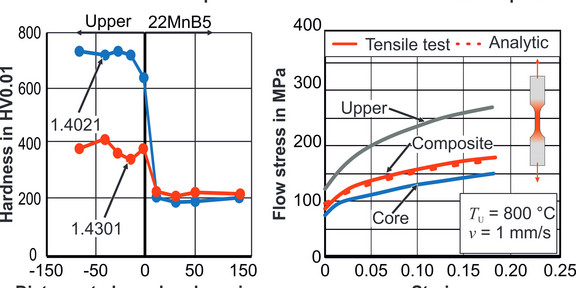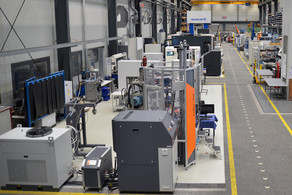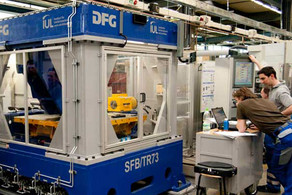Projects
Basic research on forming technology
Analysis of the Application Potential of Roll-Clad MnB-Cr Steel Composites for Press Hardening
- Profil- und Blechumformung
- Umformtechnische Grundlagenforschung
- Materialcharakterisierung

| Funding | German Research Foundation (DFG) |
| Project | 444548865 |
| Contact | Markus Stennei M. Sc. |
Press hardening is used to manufacture high-strength components. Due to the high process temperatures, the steel to be processed must be coated to protect it from scaling. As an alternative oxidation prevention, the manufacturability and formability of Cr-Mn steel composites is being investigated in this joint project together with the IBF of RWTH Aachen University. Stainless steel provides oxidation protection and enables more cost-effective and faster heating. In the project a martensitic stainless steel (1.4021) and an austenitic stainless steel (1.4301) are investigated as top layers. The measured hardness profile of the composites produced is shown in Figure a. Analytical models were presented and validated by experiments (see Figure b) in order to predict the resulting effective flow stress of the composite. In the future, these models will be used to design steel composites with different layer thickness ratios. Here, the focus is on the suitability of the new steel composites for use as semi-finished products for subsequent forming processes.
Material characterization
Analysis of the Application Potential of Roll-Clad MnB-Cr Steel Composites for Press Hardening
- Profil- und Blechumformung
- Umformtechnische Grundlagenforschung
- Materialcharakterisierung

| Funding | German Research Foundation (DFG) |
| Project | 444548865 |
| Contact | Markus Stennei M. Sc. |
Press hardening is used to manufacture high-strength components. Due to the high process temperatures, the steel to be processed must be coated to protect it from scaling. As an alternative oxidation prevention, the manufacturability and formability of Cr-Mn steel composites is being investigated in this joint project together with the IBF of RWTH Aachen University. Stainless steel provides oxidation protection and enables more cost-effective and faster heating. In the project a martensitic stainless steel (1.4021) and an austenitic stainless steel (1.4301) are investigated as top layers. The measured hardness profile of the composites produced is shown in Figure a. Analytical models were presented and validated by experiments (see Figure b) in order to predict the resulting effective flow stress of the composite. In the future, these models will be used to design steel composites with different layer thickness ratios. Here, the focus is on the suitability of the new steel composites for use as semi-finished products for subsequent forming processes.
Technology development
Analysis of the Application Potential of Roll-Clad MnB-Cr Steel Composites for Press Hardening
- Profil- und Blechumformung
- Umformtechnische Grundlagenforschung
- Materialcharakterisierung

| Funding | German Research Foundation (DFG) |
| Project | 444548865 |
| Contact | Markus Stennei M. Sc. |
Press hardening is used to manufacture high-strength components. Due to the high process temperatures, the steel to be processed must be coated to protect it from scaling. As an alternative oxidation prevention, the manufacturability and formability of Cr-Mn steel composites is being investigated in this joint project together with the IBF of RWTH Aachen University. Stainless steel provides oxidation protection and enables more cost-effective and faster heating. In the project a martensitic stainless steel (1.4021) and an austenitic stainless steel (1.4301) are investigated as top layers. The measured hardness profile of the composites produced is shown in Figure a. Analytical models were presented and validated by experiments (see Figure b) in order to predict the resulting effective flow stress of the composite. In the future, these models will be used to design steel composites with different layer thickness ratios. Here, the focus is on the suitability of the new steel composites for use as semi-finished products for subsequent forming processes.
Industry-related research
Analysis of the Application Potential of Roll-Clad MnB-Cr Steel Composites for Press Hardening
- Profil- und Blechumformung
- Umformtechnische Grundlagenforschung
- Materialcharakterisierung

| Funding | German Research Foundation (DFG) |
| Project | 444548865 |
| Contact | Markus Stennei M. Sc. |
Press hardening is used to manufacture high-strength components. Due to the high process temperatures, the steel to be processed must be coated to protect it from scaling. As an alternative oxidation prevention, the manufacturability and formability of Cr-Mn steel composites is being investigated in this joint project together with the IBF of RWTH Aachen University. Stainless steel provides oxidation protection and enables more cost-effective and faster heating. In the project a martensitic stainless steel (1.4021) and an austenitic stainless steel (1.4301) are investigated as top layers. The measured hardness profile of the composites produced is shown in Figure a. Analytical models were presented and validated by experiments (see Figure b) in order to predict the resulting effective flow stress of the composite. In the future, these models will be used to design steel composites with different layer thickness ratios. Here, the focus is on the suitability of the new steel composites for use as semi-finished products for subsequent forming processes.
Completed Projects
Analysis of the Application Potential of Roll-Clad MnB-Cr Steel Composites for Press Hardening
- Profil- und Blechumformung
- Umformtechnische Grundlagenforschung
- Materialcharakterisierung

| Funding | German Research Foundation (DFG) |
| Project | 444548865 |
| Contact | Markus Stennei M. Sc. |
Press hardening is used to manufacture high-strength components. Due to the high process temperatures, the steel to be processed must be coated to protect it from scaling. As an alternative oxidation prevention, the manufacturability and formability of Cr-Mn steel composites is being investigated in this joint project together with the IBF of RWTH Aachen University. Stainless steel provides oxidation protection and enables more cost-effective and faster heating. In the project a martensitic stainless steel (1.4021) and an austenitic stainless steel (1.4301) are investigated as top layers. The measured hardness profile of the composites produced is shown in Figure a. Analytical models were presented and validated by experiments (see Figure b) in order to predict the resulting effective flow stress of the composite. In the future, these models will be used to design steel composites with different layer thickness ratios. Here, the focus is on the suitability of the new steel composites for use as semi-finished products for subsequent forming processes.







![[Translate to English:] [Translate to English:]](/storages/iul-mb/_processed_/0/f/csm_Forschung1_2880x640_patrick_7b98a9cf47.png)